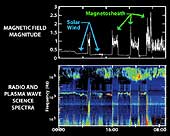|
COMETS EARTH JUPITER KUIPER BELT MARS MERCURY METEORITES NEPTUNE OORT CLOUD PLUTO SATURN SOLAR SYSTEM SPACE SUN URANUS VENUS ORDER PRINTS
PHOTO CATEGORIES SCIENCEVIEWS AMERICAN INDIAN AMPHIBIANS BIRDS BUGS FINE ART FOSSILS THE ISLANDS HISTORICAL PHOTOS MAMMALS OTHER PARKS PLANTS RELIGIOUS REPTILES SCIENCEVIEWS PRINTS
|
Related Documents
Download Options
This graph illustrates the series of sonic booms that took place when the Cassini spacecraft crossed Saturn's bow shock. A bow shock is a shock wave located where incoming solar wind meets a planet's magnetosphere, or magnetic bubble. Differences in electrical charges cause the solar wind to curve around the magnetosphere in the same way that air flows around a supersonic airplane. The resulting turbulence is heard as a sonic boom and is represented here as an increase in wave frequency. Scientists were surprised to discover that Saturn's bow shock was located at a distance of 3 million kilometers (1.9 million miles) from Saturn, much farther out than they had predicted. Because the bow shock acts like a balloon when hit, oscillating in and out, Cassini actually crossed it several times, resulting in the seven sonic booms depicted above. Red denotes louder waves, and blue quieter. This data was taken by Cassini's radio and plasma wave science instrument. |
